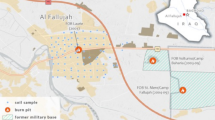Abstract
Background, Aims and Scope
Contaminated land is a high priority environmental problem in most of Europe and North-America. Sweden is no exception and generic guideline values have been developed for the initial assessment, but site-specific assessments are also needed. The generic guideline values are not applicable when the exposure conditions are different from the typical Swedish conditions or when the site contains a particularly sensitive ecosystem. The Swedish guideline values have, like in many other countries, been set by using deterministic point estimates for all variables and constants in the used multimedia model. The same approach is common also for site-specific assessments, and a limitation is that it fails to quantify variability and uncertainty. Probabilistic risk assessment provided a method to deal with this problem. Variability and uncertainty in the input parameters (variables or constants) are described by probability distributions, and likewise the output (risk or exposure) is presented as a probability distribution. A substantial number of probabilistic risk assessments for contaminated land at sites in North America, Europe and Asia have been published. However, an extensive review of the literature did not identify any study where probabilistic risk assessment was applied to a site contaminated by an iron or steel industry. Here we will describe such a case, where we have compared a deterministic point estimate with a probabilistic risk assessment for six elements and benzo[a]pyrene.
Methods
The site had different metallurgical plants in operation for more than 100 years. Most parts of the steel mill were closed by the mid 1980s, and today the site is used by small-sized enterprises. The soil is contaminated with metals from the previous industrial operations. The present owner plans to develop the site and has therefore initiated extensive investigations of soil contamination. Sixty-two soil samples collected between 1997 and 2000 provided a good coverage of the whole site, and were analyzed for the content of different elements and polycyclic aromatic hydrocarbons (PAH). The exposure assessments were focused on six elements with high concentrations compared to the generic guideline values; arsenic (As), lead (Pb), cadmium (Cd), chromium (Cr), copper (Cu) and zinc (Zn). In addition, benzo[a]pyrene was included due to the high toxicity and comparatively high concentrations. Variability and uncertainty were characterized in a Monte Carlo simulation of exposures (10 000 iterations), and the exposures were evaluated with two land use scenarios; less sensitive use and sensitive use.
Results and Discussion
The deterministic point estimates and the probabilistic estimates of the 95th percentile are in approximately the same ranges in the scenario of less sensitive land use. It is only the exposure for arsenic that is slightly above the toxicological reference value (TRV) in the deterministic assessment. In the probabilistic assessment, the exposure for all elements is below the TRV. The results for sensitive land use are applicable to a scenario where the site is developed for general housing. The deterministic point estimates and the probabilistic estimates of the 95th percentile are also here in approximately the same ranges, but the exposure exceeds the TRV for arsenic, cadmium and lead. Drinking water, vegetables grown on site and soil ingestion are the major exposure pathways for this scenario. In this assessment, the estimated intake distributions are applicable to a randomly selected individual. The probability distributions used here to characterize the different soil parameters are typically representing both variability and uncertainty, and the same is true the majority of the exposure variables. We therefore decided not to attempt to separate variability and uncertainty at this stage, but with additional data from a more in-depth site investigation it might be possible to achieve this.
Conclusions and Outlook
To the best of our knowledge, this study is the first report on a probabilistic risk assessment on a former iron and steel works site. The materials handled by this industry were less toxic than for many other metallurgical operations, but contaminants may still severely limit the options for future land use. This case study shows that probabilistic exposure estimates for a set of soil contaminants can be quite similar to deterministic point estimates. The main difference is instead to be found in the additional information obtained with the probabilistic assessment. The sensitivity analyses show pathways and input variables that contribute most to variations in the total intake of each contaminant, e.g. dermal contact and ingestion of soil, vegetables and drinking water. This information can be used both in the planning of future land use and for active measures to reduce current exposure. The probabilistic assessment also provides information on the magnitude of exposure and the margin of safety. This information may facilitate risk communication between decision-makers and stakeholders. The presentation of results from probabilistic risk assessments is only briefly discussed in the literature and here we see a need for research and opportunities for enhancement. The choice of data analytical tools may then be of importance, since more complex multimedia models are rather difficult to decipher when implemented within traditional spreadsheet software. Some of the research needs are identified here and in a previous review article in this journal.
Similar content being viewed by others
Author information
Authors and Affiliations
Corresponding author
Rights and permissions
About this article
Cite this article
Sander, P., Öberg, T. Comparing Deterministic and Probabilistic Risk Assessments. A case study at a closed steel mill in southern Sweden (7 pp). J Soils Sediments 6, 55–61 (2006). https://doi.org/10.1065/jss2005.10.147
Received:
Accepted:
Published:
Issue Date:
DOI: https://doi.org/10.1065/jss2005.10.147




